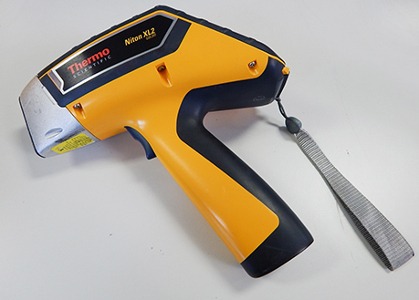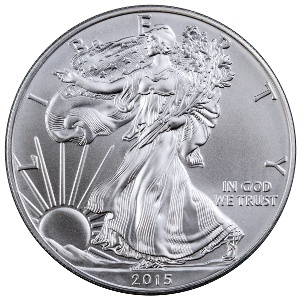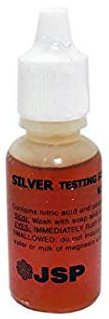Any valuable item is going to have fakes. It's unfortunate but it's reality and silver is no exception. There are fake silver coins, bars, flatware, etc. Spotting fake silver is a great skill to have, especially if you are a coin dealer. It's also a good idea to test your own silver, just to makes sure that it's real or in the event that you want to sell your silver.
Here we give you the top ways to spot counterfeit silver. We have methods for any type of silver, and specific methods for silver coins.
Note: Fake silver can pass some of these methods. Therefore it's good to try multiple methods in order to determine a fake.
For Any Type of Silver
The tests below apply to any type of silver such as bullion, rings, necklaces, flatware, etc.
Acid Test
The most accurate test, it will require you to buy test acid for silver. The acid itself is usually a mixture of nitric acid and muriatic acid. So be careful with the acid solution and make sure to wear gloves and eye protection. Some people try to save money by using vinegar instead of acid but vinegar won't give you accurate results.
For this test, you just put a drop of acid on your silver item. If the acid turns the wrong color then it's fake. If it turns the correct color then the silver is real. You will need to closely follow the instructions that came with your acid solution.
You could also take a silver item and rub it against a testing stone. You would then put the acid on the stone. This works best for silver chains.
This test is not recommended for coins because you will damage the coin's surface.
If your item is silver-plated then you will need to file through the surface of your item in order to get to its core. In addition
Eye Test
Does it pass the eye test? Do you know what silver should look like? If you have experience dealing with silver then you get to know the look of it. It shouldn't be too shiny but it should still have a little shine to it.
You can also look at the overall quality of an item with a jewelers loupe and see its craftsmanship as well as the engraving. If an item has poor craftsmanship then it's more likely to be a fake.
Magnet Test
Silver is non-magnetic. So if a piece of silver sticks to a magnet, then you can be sure that it's fake. This test can easily weed out fakes that are made of steel or iron. However this isn't a definitive test because many fakes can pass the magnet test.
There is also the magnet slide test. Silver is paramagnetic so if you slide the magnet down a piece of silver, then it will go down slowly. If you test a piece of fake silver, then the magnet will either stick or slide down quickly.
You want to use a strong magnet when conducting any magnet test. We advise using a rare earth magnet.
Ice Test
This is an easy and inexpensive test to do- all you need is an ice cube.
Silver is a good thermal conductor. So if you put an ice cube on top of your silver item, then the ice cube will start to melt quickly. An ice cube placed on silver will melt quicker than on iron and a little quicker than on copper.
The easiest way to conduct this test is to place a real silver coin and a potentially fake silver coin side by side. Put an ice cube on each coin and then check to see how quickly each ice cube melts.
Ping Test
Here is a test that is easy and free to do.
When you hit real silver with another piece of silver it creates a ping noise. With real silver it creates a high-pitched ping noise that lasts a certain length. It lasts longer on real silver than on fake silver.
This test will not damage your coin very much, but it's still not a good idea to do it on numismatic coins.
XRF Analyzer

XRF stands for X-ray fluorescence. An XRF analyzer will scan an item and both detect and identify its metal contents.
These products are very expensive, retailing for thousands of dollars. So if you're just a small collector then you wouldn't need an XRF analyzer. It only makes sense for a large pawnshop, coin shop, or jewelry store to buy one. You could buy a lot of real silver for the cost of one of these products.
For Silver Coins
Here are two methods that apply specifically to silver coins.
Weight Test
The weight that is engraved on a coin or bar should match up to its actual weight. So 1 oz coins should weigh 1 oz. To measure the weight properly you need to have a calibrated scale that is accurate to at least .1 grams, although .01 grams is preferable.
If you don't have a calibrated scale then the weight test can still work. You just need a real coin to match up with your potentially fake coin. It needs to be the same type of coin, for example take two American Silver Eagles.
Put the real coin on the scale and record the weight. Then take the other coin and record the weight. If there is a different of more than a few grams then you definitely have a fake. For two real uncirculated bullion coins, there shouldn't be any difference at all.
Specifications Test
The specifications test is simple but it requires a bit of research.
You just look up the actual specifications of the coin in question and then compare them to your coin. Here is what you should look at: denomination, date, quality, weight, diameter, thickness, and edge type.

For example here are the specifications for the popular American Silver Eagle coin:
| Denomination: | $1.00 |
| Date: | 1986 to Present |
| Quality: | Uncirculated, Proof, Bullion |
| Weight: | 1.000 troy ounces (31.103 grams) |
| Diameter: | 1.598 inches (40.60 mm) |
| Thickness: | 0.117 inches (2.98 mm) |
| Edge Type: | Reeded |
It's helpful to take the real coin, and then visually compare the dimensions side by side to the potentially fake coin. It's even better if the coins were minted in the same year, otherwise there could be some small differences.
With a jeweler's loupe you can also examine the coin's detail. One of the biggest red flags is the font. If there is a different font or a different font size, then you're probably looking at a fake.
Conclusion
A combination of these tests can determine the legitimacy of your silver. However to save you time and to put your mind at ease, it's best to order silver from a reputable dealer. Check out our silver buying guide to learn more.
Also note that most of these tests also work for gold. So if you have gold then check out our article on how to test gold.

